How to Make a Year-Long Non-Fiction Literacy Center for Kindergarten
Create a year-long literacy center using non-fiction books that kindergartners love.
Here is why and how I created a literacy center based around non-fiction in my kindergarten classroom.

Plus, you can get your hands on all of the printable materials for free so you can make this center for your classroom too.
Why a non-fiction literacy center?
I want my students to be reading and exploring all kinds of books during their literacy centers – I want them to develop a love for reading.
Most kindergartners have an innate love of non-fiction. They are so curious and absorb so much information through non-fiction books that it helps satisfy their curiosities and also generates more questions about the world.
So, why not a center that focuses on non-fiction?
If you tell me creating a whole center around non-fiction books that they can read at their independent level isn’t possible… then you’re missing the point.
They should be doing age-appropriate “reading” of books of all levels because this center is designed to place interest first. Hook them on the topic and get them to want to read the content.

If it’s simply using the pictures, diagrams, and illustrations to learn then so be it. If they learn to look at captions, tables of contents, or find words they know, then it’s all icing on the cake.
Save the “books only at their level” thinking for another leveled-reading-specific center like the puppet center.
This literacy center uses a few activities to engage students in looking for vocabulary words in non-fiction texts and allows them to explore non-fiction with meaning in an age-appropriate way.
I label it the non-fiction center for administration… as a class we call it the science center.
What is the non-fiction literacy center?
The non-fiction center is a set of book baskets and purposefully collected materials to connect young emergent readers to books on topics they love or may find fascinating.
Students can use manipulatives to engage with content. This makes it kinder-friendly and makes semi-difficult concepts more age-appropriate.
But the neat thing is that your kinders will most likely end up spending tons of time reading (and pretend reading – but don’t negate the value of that) non-fiction books that will be at a reading level that far surpasses their current independent reading level.
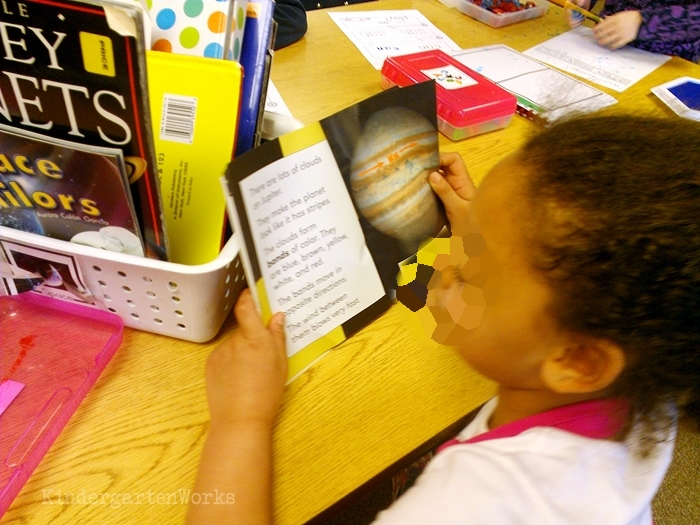
That is huge.
Creating a desire to read by sparking interest can do wonders for the brain plus they will begin to pick up on features of non-fiction books too.
How to make it successful
Here are 3 main things I think help make this center successful:
- The topics/themes can be rotated throughout the year which keeps student-interest high
- Students have choices at the non-fiction center – choosing which toipcs they’d like to explore
- It is an open-ended, choice-based center – they choose which activities to use to engage the texts

Students can choose to do one or all of these activities while at this center:
- Read non-fiction books
- Type vocabulary words into a pretend laptop and look for them in books
- Look for vocabulary word matches in books
- Sort related objects or word cards
- Write questions and wonderings related to their learning
How to set up this center
You can organize this center in any way you see fit, or using materials you already have.
I’ll share what I did.
Organization
To begin I used a skinny plastic shoe box from the dollar store for each topic.
I kept the loose manipulative materials in zippered pouches (like the zippered plastic pouch a new sheet set comes in) since I used whatever I could get my hands on for free.
The laptop and sorting activity mats were simply slipped into the bucket along with the books.

This setup worked until some of my sets literally kept falling over from the weight of books. I had a lot of books on some topics.
Those topics that had a lot of books needed a wide, flat, white sturdy Sterilite basket to keep everything together. This worked better.
I added a binder to organize the activities and manipulatives. This worked awesome.

The binder had:
- a zipper (pencil) pouch to hold the sorting materials or cards
- a sorting mat
- a pretend laptop with vocabulary
It made cleaning up and storing everything so much more organized and easier for my kinders.
Rotate materials
In order to keep this center feeling fresh, I changed out the non-fiction themes/topics about every 6-9 weeks.
Sometimes I’d leave a topic out longer if students were still really into it, or I’d change out all of the topics.
I’d also bring back themes/topics again later in the year. It was amazing to see what they’d learn new and get out of the books differently – now that they were a few months older.
Offer a few options
My kinders only went to this center once a week, so I decided that six tubs to choose from was enough variety to last that amount of time and it fit the shelf space I had nicely.
I labeled all of the books and materials to make getting materials back to the right tub/basket easy.
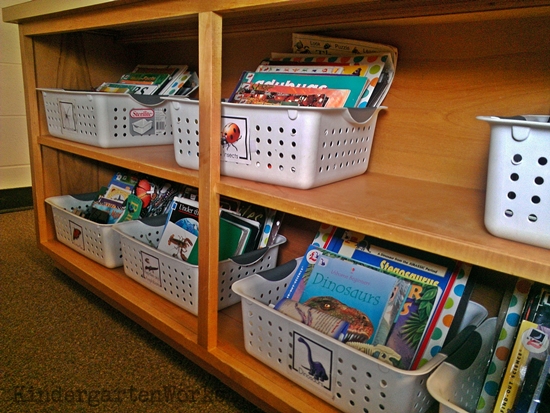
It is very similar to the way I label my classroom library.
If six topics at once are too many for your class to handle independently, then simply change the number offered to what works for you.
What topics should I include?
It doesn’t really matter what topics you put in a non-fiction literacy center.
I just started with a few and added to them as I found stacks of books in my cupboards that I felt could be put to better use… and wanted to get them into the hands of my kinders.
Some ideas for non-fiction topics you might consider: frogs, space, hibernation and migration, clouds, weather, insects, nocturnal animals, jobs and occupations, vehicles, etc.
You could use topics that coordinate with your science curriculum too. That’s an easy win.
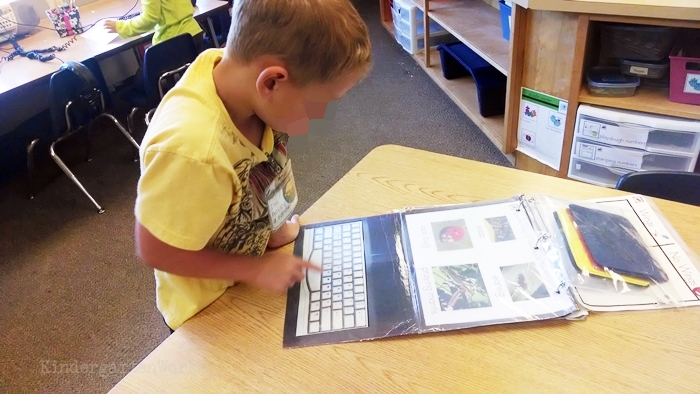
I have a list of 14 themes that we used and that I created materials for. In fact, I have printable activity resources to go with each topic!
Click here to see the list of non-fiction literacy activity set themes you can use in your classroom.
What standards does this center hit?
As with any center, I made sure I could prove what standards my students were working on.
I posted the Common Core Standards that each activity helps meet for any administrators walking through.

- K.RF.1 – Demonstrate understanding of the organization and basic features of print.
- K.RI.1 – With prompting and support, ask and answer questions about key details in a text.
- K.RI.2 – With prompting and support, identify the main topic and retell key details of a text.
- K.RI.3 – With prompting and support, describe the connection between two individuals, events, ideas, or pieces of information in a text.
- K.RI.4 – With prompting and support, ask and answer questions about unknown words in a text.
- K.RI.5 – Identify the front cover, back cover, and title page of a book.
- K.RI.6 – Name the author and illustrator of a text and define the role of each in presenting the ideas or information in a text.
- K.RI.7 – With prompting and support, describe the relationship between illustrations and the text in which they appear (e.g., what person, place, thing, or idea in the text an illustration depicts).
- K.RI.9 – With prompting and support, identify basic similarities in and differences between two texts on the same topic (e.g., in illustrations, descriptions, or procedures)
Consider the manipulatives and activities as one way to provide some “support” as these standards suggest. Students can use the support provided without you directly being the support.
If you like this poster, you can download it here for free. I’ve also included the icons for your literacy center workboard so you can put it into your center rotation.
[terms of use] [downloading help]
Now, go and print off the free themes/topics you love to get started making your own non-fiction literacy center.
Let’s wrap it up
There you have it – why you should have a non-fiction literacy center in your kindergarten classroom and how to make it happen.
This turns out to be a really neat center and has been in use for years in my classroom now.
I hope that the tips for putting yours together along with the printable poster and icons are helpful.
This center is just one of fifteen centers that can long all year long in your classroom. Want to read about the other ones? Check out How to create smart literacy centers that last the whole year.
If you like what I do here on KindergartenWorks, then be sure to subscribe today. I look forward to sharing ideas with you weekly.





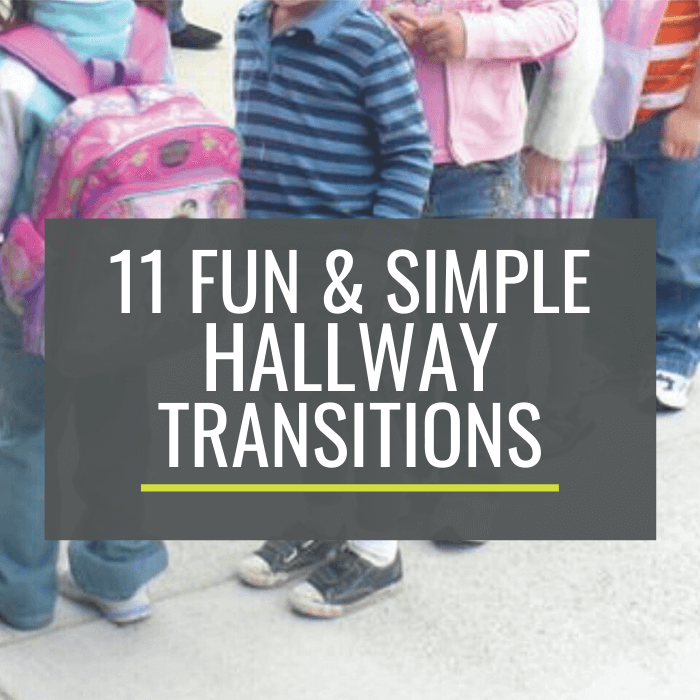

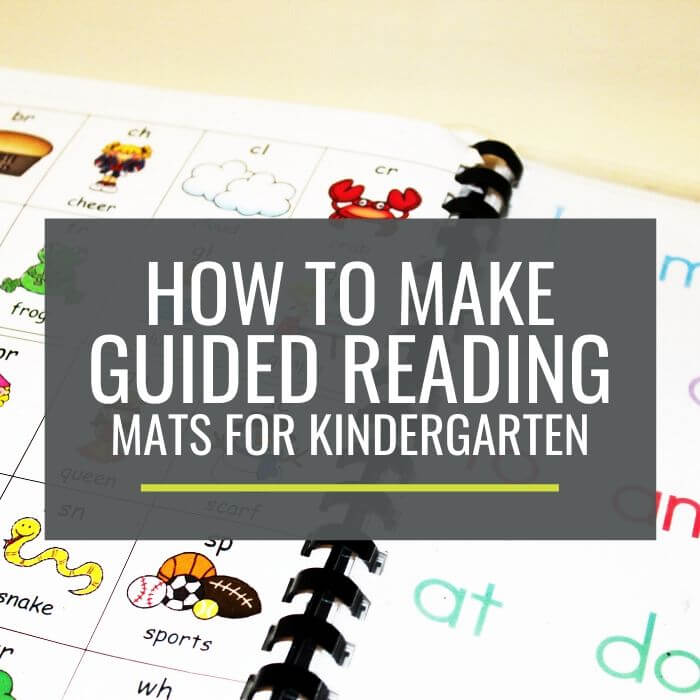
I would love a copy of your nonfiction reading materials.
Would love this!
I would love to get your ocean life, alphabet, pumpkins, butterflies, human body, insects, and farm literacy center activities!!
I would love an example of this so I can create my own!
I would really love a copy of all of your non-fiction literacy centers. Thanks!
LOVE this idea! I have a deep affection for non-fiction materials, and I love the way to incorporate some fun by using “toys.” I think playing with things in school gets a bad rap, and that it really is beneficial for children’s brains to use items in a playful way. This center combines the best of two worlds- focusing on standards, but giving kids what they yearn to do (and sadly might not get to do much at home).
I’ll be new to teaching Kindergarten next school year and love looking through your blog for ideas. You inspire me that I will be ok with those kinders (after teaching everything else from 1st-5th!). Thanks for all of the ideas!
Hi! I am new to the world of kinder and I have been experimenting with my centers. I love your idea of a non-fiction center. May I please get whatever resources you have for it?
I would love to have a copy of your non fiction reading materials and activities for centres. Especially the construction and dinosaurs. I’m always looking for ways to get my boys to write.
Thanks
I would greatly appreciate your help with the nonfiction center materials. They look wonderful!
Thank you,
Alisa
You have creative and common sense ideas that can be easily implemented by using literature books and various materials already located in our classrooms. I love the “laptop” idea for introducing and learning vocabulary. Thank you for providing the links to access the materials for setting up the literacy stations. Please tell me where I can find the link for the copy of the “laptop”.
Thanks Stephanie – creative and common sense is working smart by my standards 🙂 The link for the laptop items are in the free download. You can sign up for that just above these comments.
I love these non-fiction centres and have just finished making them! Do you have any more available?
Wonderful! Thanks – I don’t currently have more available online. It’s in the plans someday to get them all set to go for you guys. So glad you love them.
– Leslie
Hi, I can’t seem to download these resources – could you add a new link as the dropbox no longer is active?
Wow! This is awesome! Off to start pulling resources and try it out for next year! Thanks!
Thanks Kerry! Enjoy!
– Leslie
Genius! I (cough cough) might be a slight hoarder – and have all kinds of {extremely important items that I just can’t imagine parting with but they sit in my supply closets all year long} materials that would fit perfectly with this idea.
Come on summer, I have lots of projects to do! Thanks for sharing this great idea!
Ha ha. Thanks Arianne! So cool – I’d love to see what you create!
I love the ideas and the way you organized them! Renee
Thanks Renee!
Love your blog! I just started one and would love if you would go follow it.
totallyterrificteachingtools.blogspot.com
Lohren Nolan
Thanks Lohren – I’m off to follow you! If you already know how to leave your blog link in comments, you’re way ahead of where I was just last year!
This is wonderful! I’ve been wanting to revamp my science center for a couple years now.. I feel it’s too Pre-K ish. 🙂 This will beef it up for sure. Thanks again for sharing!!! 🙂
Katy
[email protected]
Thanks for sharing your thoughts Katy! I find they really get into the books and that’s what we’re after!
This is great!
Jennifer
First Grade Blue SKies
Thanks Jennifer!